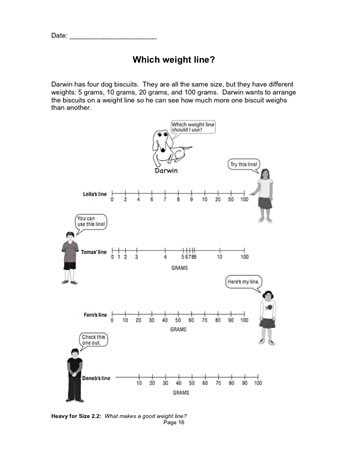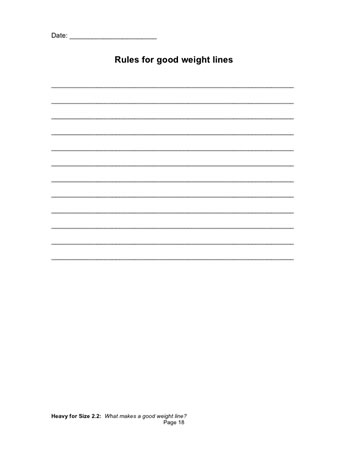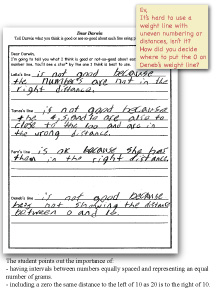What makes a good weight line?
Plan Investigation 2.2
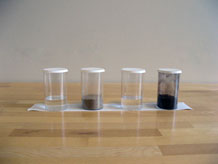
Scientists often use tables (as we did in the last investigation) to organize and represent the data they collect. However, there are other ways to represent data, and some representations are better than others for highlighting different aspects of the very same data set. In this investigation, we look again at our "equal volumes of different materials" data but this time using a measure line (weight line) instead of a table.
Formative Assessment
Do students understand the basic characteristics of a “good” weight line?
Available online at inquiryproject.terc.edu
Students study a set of weight lines, some of which are poorly constructed. Through their analysis of these lines they discover the essential characteristics of a good weight line: these include appropriate starting and ending points and a regular pattern of line spacing and number progression. These characteristics allow our eyes to make sense of the relationships between objects on the line. The weight line is an explicit representation of the closeness or distance between the weights of a set of objects; its geometry plays an essential role. Careful work with weight and volume measure lines lays a foundation for later understanding of information displayed in conventional graphs.
By the end of the investigation students will be able to construct their own weight lines for their earth materials — a challenge they will undertake in the next session.
Learning Goals
- Understand what makes a good weight line
| Sequence of experiences | ||
|---|---|---|
| 1. Ask the question | All Class | 15 Mins |
| 2. Explore weight lines | Individual | 15 Mins |
| 3. Develop rules for weight lines | Discussion | 15 Mins |
Materials and Preparation
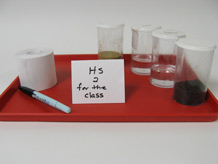
For the class:
- Post the investigation question in a place where all students can see it.
- Begin a class list with the title "Rules for a Good Weight Line" and post it where everyone can see it.
- Class data table for earth material weights (from the last investigation)
- 1 strip of adding machine tape
- 1 capped 150cc container with exactly 40cc of fresh water (from the last investigation)*
- 1 capped 150cc container with exactly 40cc of mineral oil (from the last investigation)*
- 1 capped 150cc container with 40cc of sand (from the last investigation)*
- 1 capped 150cc container with 40cc of organic soil (from the last investigation)*
* These 4 containers will also be used in the next investigation.
Concept Cartoon

The Weight Line Concept Cartoon is part of this investigation and is in the student science notebook.
Do students understand the basic characteristics of a “good” weight line?
For evidence, look at responses to the Dear Darwin Concept Cartoon. Use these criteria as you interpret students’ critiques of the 4 weight lines:
- Are the distances between neighboring tick marks equal in length?
- Do equal lengths represent equal differences in weight?
- Does the weight line start at 0?
- Is there a place on this weight line for each of the dog biscuits?
As a next step you might provide a small set of objects and their weights. Ask students to help you create a “good” weight line.
1. Ask the question
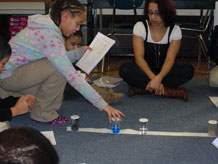
Hold up the four containers of earth materials. Recall the last investigation, and establish that the containers hold the same volume of four different materials.
Were the weights the same?
Confirm that one of the materials was much "heavier for its size" than the others.
- Which of the earth materials was heaviest
- sand
- Which was lightest?
- organic soil
- And the two in the middle?
- mineral oil and water
As the students answer, place the materials in a line on the blank strip of paper. Put them in weight order, an equal distance apart. Encourage students to consult the data from their notebooks or class chart to determine "how much heavier." Discuss the way the containers are arranged and the way the data are represented in the class table.
- Right now the containers are arranged to show their weights from lightest to heaviest. But does this arrangement show how much heavier some containers are than others?
- Can you think of a way to arrange the containers differently, so that someone could tell, just by looking, which materials are close in weight and which are much heavier or much lighter than others?
Ask a volunteer to spread the containers along the paper strip to show how the weights of the materials actually compare. Do students agree with the result? Do others have different suggestions? Let them know that the data display they are creating is called a weight line.
- Is there anything we can do to show the data even better?
- write down the weights, mark intervals on the line, etc.
Introduce the investigation question:
What makes a good weight line?
2. Explore weight lines
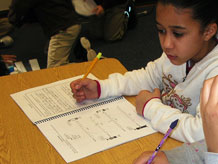
Students evaluate four weight lines in their science notebooks [Which weight line?]. The work is presented through a concept cartoon involving five characters. One of them, Darwin, a dog, has four dog biscuits. The biscuits are all the same size but have different weights: 5 grams, 10 grams, 20 grams, and 100 grams. Darwin wants to arrange the biscuits on a weight line so he can see how the weights compare. In the cartoon, four characters show Darwin their weight lines.
Ask students to place the four biscuits on each character’s weight line. When they are done, have them talk in their groups about the strengths and weaknesses of each weight line and then write a letter about them in the notebook [Dear Darwin].
In fact, three of the weight lines are problematic; only Fern's is well constructed. As you circulate among the students, see if they are noting some of the difficulties — improper endpoints, erratic intervals, missing units of measure, etc. — but do not comment on them at this time.
- What makes a good weight line?
3. Develop rules for weight lines
Purpose of the discussion
The purpose of the discussion is for students to consolidate their ideas about what makes a good weight line and to recognize the importance of consistent measurement. Return to the investigation question for the discussion.
Engage students in the focus question
Students’ initial discussion of the concept cartoon sets the stage for consolidating ideas about the investigation question:
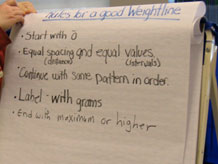
What makes a good weight line?
Ask students to share their thoughts about the four weight lines in the concept cartoon, and then pose a challenge:
Could we make a list of rules for good weight lines?
Help specify students’ thinking. Why do they think this is a good rule? What would happen if the rule was not followed? In particular, help students understand that a good weight line will accurately represent the "closeness" or "distance" that the weights have each to each. That way our eyes can make sense of their relative weights. In other words, a good weight line will show how much more one thing weighs than another.
As the class agrees on some rules, record them on the list you prepared before class and have students copy them into their notebooks [Rules for good weight lines].
Some rules for good weight lines:
- The line should start at zero.
- The line should end at a value higher than the heaviest object that will be placed on it, but not much higher; this is called giving an appropriate range.
- The unit of measure should be clearly indicated.
- The line should include some weight marks showing some values between zero and the end value.
- The weight marks should be evenly spaced, and the distance between marks should represent the same amount of weight each time; the distance between the marks is called the interval.
- The interval doesn't have to be 1 unit; it could be any regular increase, e.g., 2g or 10oz or 50lb — whatever best suits the purpose of the line.
- The line should be long enough to show the information clearly.
Summarize the Discussion
Leave them with this thought:
Now we have some rules for good weight lines. Do you think you can make a good weight line that can show how the weights of sand, soil, water, and mineral oil compare — that can show how much heavier one is than another? In what ways would your weight lines be the same?
Save the class list for the next investigation.


